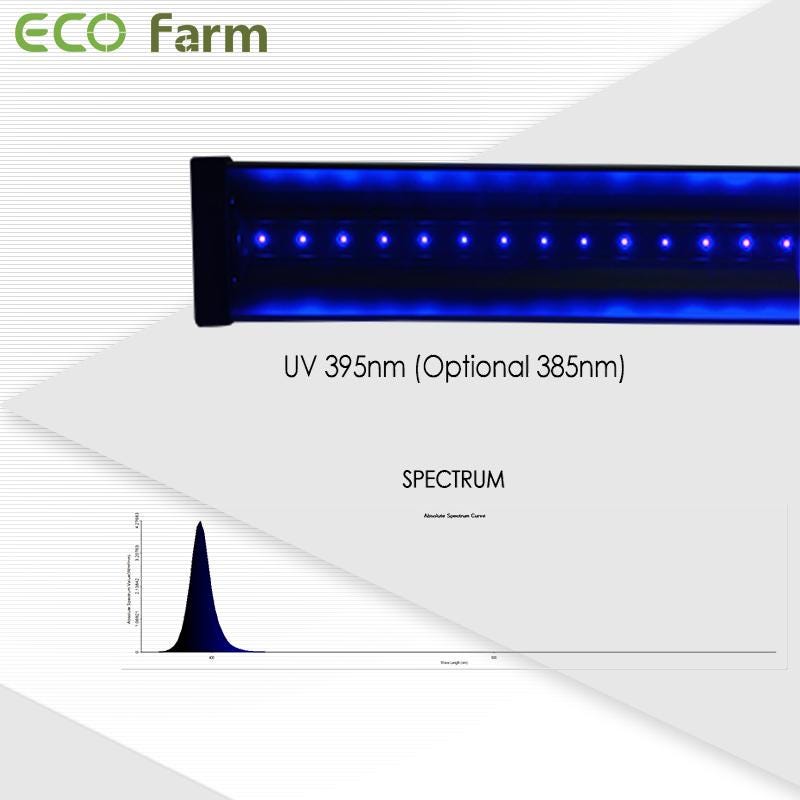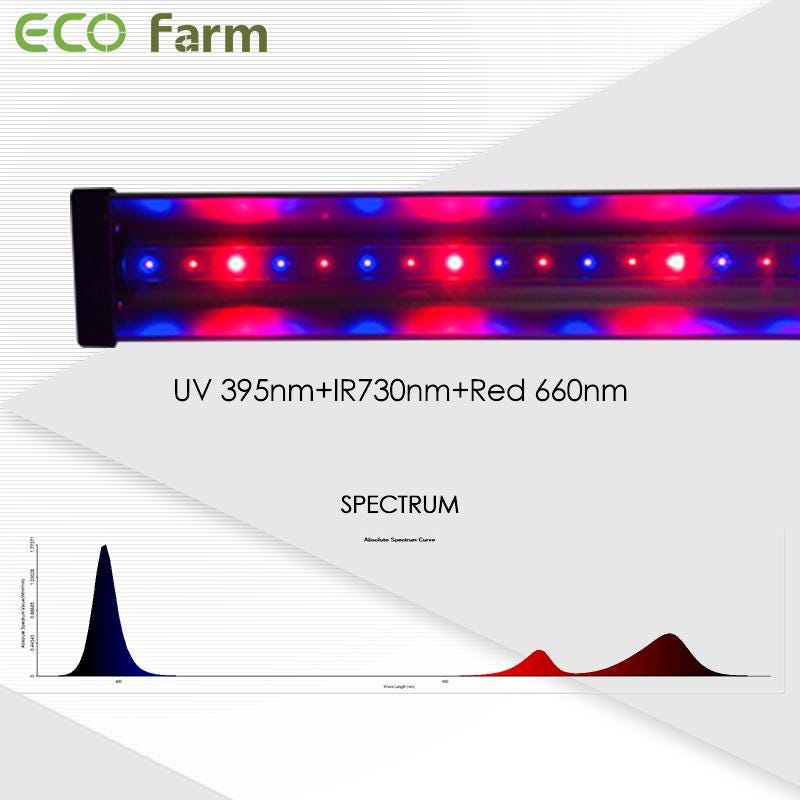Can I Use Any Blue And Red LED Light to Grow Plants?
Growers generally have two options when it comes to horticultural LED spectrums — “full-spectrum” or “broad-spectrum”, which appears as white light; and “red/blue spectrum”, which can appear as purple or pink light.
The red/blue spectrum LED luminaires are often referred to as narrowband spectrum lights — because the wavelengths they emit are within a narrow band of light. LED luminaires that emit “white” light are often referred to as “broad spectrum” or “full-spectrum” lights because they include broadband of the light spectrum (more similar to the sun) which renders a “white” light (there are no true white wavelengths).
It should be noted that essentially all “white” LEDs are blue LEDs that are coated in a phosphor that converts the blue light into longer wavelengths. The phosphor absorbs the blue light and re-emits some or most of the photons into green and red light. This coating reduces the efficiency of the LED grow light in converting photons into usable PAR (photosynthetically active radiation) light but makes for a better work environment in sole source applications. The composition of the phosphor coating will help to determine the spectral quality of the white light emitted. To find the efficacy of your luminaire, you will need to divide the Photosynthetic Photon Flux (PPF) of the luminaire, by its input wattage. The resulting efficacy value will be represented in μmol/J. The higher the number, the more efficient the luminaire is at converting electrical energy into photons of PAR.

Red/Blue LEDs
The “purple/pink” LED luminaires that many associates with horticultural lighting, use varying combinations of red and blue LEDs, and are recommended for greenhouse growers who are already receiving the full spectrum of light from the sun. Since photosynthesis peaks in the red and blue wavelengths, it makes this spectrum, not only the most efficient for plant growth but also the most energy-efficient. From this perspective, if you are already getting full-spectrum sunlight from outdoors, it would make the most sense to put most of your energy into wavelengths that are most optimal for photosynthesis, and where you will see the biggest energy cost savings. This combination is more energy-efficient than “white” or full-spectrum LEDs because blue and red LEDs have the highest photon efficacy compared to other colors i.e. they convert the highest amount of electricity in photons, so you are getting more growth from your plants per dollar spent.

Why Your Plants Need Blue and Red Light
First, let’s cover some light spectrum basics.
To thrive, your plants need plenty of photons that fall within the PAR range. PAR refers to “photosynthetically active radiation.” In short, these are the wavelengths your plants actually use for photosynthesis.
The PAR range spans from 400–700nm. Blue light sits at one end of that spectrum, while far-red sits at the other.
As you know, blue light is a major player in the vegetative phase. Blue promotes root development and strong, stocky plant growth. When you blast your young plants with blue, you prepare them to sustain a ton of buds in the future.
Red light, on the other hand, does its best work in the flowering phase. A higher intensity of red promotes a higher yield.
Then, it follows that you do need light sources to provide both the red and blue light spectrum. But red and blue are only the beginning. There are a few more considerations that help you choose the right lights.
So, why do we need a combination of red and blue to grow plants, why can’t we use just blue or just red LEDs? While red is most efficient for photosynthesis, having only red light would result in poor growth such as very elongated stems, so blue is added to keep plants compact and a more typical shape. On the other hand, you can’t grow plants under only blue light either, as their growth and development will be adversely affected. Researchers have found over the years, that having a combination of high red light to a lower percentage of blue light has been shown to be optimum for the production of greenhouse crops that are already receiving light from the sun. Since there is no “ideal spectrum” for greenhouse crops, most LED manufacturers offer a fixed ratio of red to blue that has been deemed the most optimum for horticultural crop growth and production.
Full-Spectrum “White” LEDs
While in a greenhouse, the outdoor sunlight will balance out the “pink or purple” light emitted from LEDs, the same spectrum in a sole-source, the indoor application delivers a limited spectrum of light to the crop and can be unpleasant to work under. Therefore, many indoor growers have shifted away from narrow-spectrum LEDs, to “white” broad-spectrum LEDs.
Broad-spectrum LEDs have lower efficacy than red/blue LEDs due to conversion, energy, and optical losses within the phosphor conversion process. However, since in indoor applications where the luminaires are the sole source of light, broad-spectrum LED luminaires are far better than red/blue since they emit a wide range of wavelengths for your crop throughout the different growth stages. This is important because as we do more research, we are discovering that wavelengths such as green, which were previously thought of as not very useful, are proving to be important in photosynthesis and certain morphological responses. Additionally, many full broad spectrum luminaires can also emit energy in the far-red region, which can help promote stem extension and leaf expansion.
What is the Ideal Grow Light Spectrum for Plants?
The ideal grow light spectrum for plants depends on several factors. These include how specific plants use PAR-spectrum light for photosynthesis but also the wavelengths outside of the 400–700nm range. This light can help accelerate flowering, increase nutrition, speed up the rate of growth, etc. If the light source is sole (indoors) or supplementary (greenhouses) also affects which grow light spectrums should be used.
Generally, photosynthetic efficiency occurs at the red and blue peaks which means plants absorb these spectrums most when growing. You might think the ideal grow light spectrum is equal to sunlight — after all, it’s had millions of years of experience — however, it’s more detailed than this.
Sunlight produces a lot of greens, yellows, and oranges — they’re the most readily available spectrums of light. In fact, studies tell us how green light, while not absorbed by chlorophyll as well as red and blue (hence why most plants appear green), it’s absolutely critical for photosynthesis.
Light spectrums outside of blue and red wavelengths are used least by plants to grow as reds and blues are where most photosynthetic activity occurs — a big reason why full-spectrum grow lights are incredibly efficient because a grower can get very specific.
Conclusion
There’s a great deal of information and science to take on board as we understand the way plants interact with different light spectrums. Optimizing yield production and consistent quality of plants we’ve learned are attributed to light spectrums used together — much like natural sunlight.
We’re constantly developing our knowledge and research of how light spectrums on specific crops and strains work best — and at which time during a plant’s light cycle. Our LED grow lighting systems are designed and developed using detailed scientific research to give growers the control of using the ideal light spectrum for optimizing the yield, quality, and variability of their plants.
评论
发表评论